by Beth Bolles | Aug 23, 2013
We often consider the end of summer a time when nuisance insects are decreasing in numbers, but there is one insect that is reaching peak numbers at this time of year. The Stable Fly or Dog fly, Stomoxys calcitrans, can occur at all times of the year, but populations are heaviest in late Summer through early Winter along the Gulf Coast.
Resembling the common house fly, stable flies are persistent pests in their search for a blood meal. They have a painful bite due to specialized mouthparts that resemble sharp thorns that rasp the skin. Luckily, most people do not have an allergic reaction following a bite.
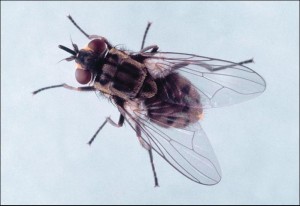
Stable flies breed in many types of moist or decaying vegetation, including seaweed deposits along the beach. Each female can lay about 500 eggs and the typical fly maggots feed in the vegetation before pupating into the adult. The entire life cycle takes several weeks.
Spraying a pesticide to control adult stable flies outdoors is not a practical option for homeowners. Rather, control methods should be directed at their breeding sites to reduce numbers. This includes allowing manures, plant debris, or crop residues to dry quickly by spreading them thinly over an area or composting them properly.
Following hurricane events, local agencies may manage stable fly populations with pesticides, but these flies do not often warrant the use of such limited resources for control.
For more information, consult this UF / IFAS publiction about the Stable Fly.
by Sheila Dunning | Aug 23, 2013
At the halfway point through 2013, cumulative rainfall amounts for the calendar year were near normal, on average, across the Northwest Florida Water Management District. January, March and May were rather dry. Yet, February, April and June had an abundance of rain. Then, in early July, an unusual persistent mass of moist tropical air brought intense rainfall to the Florida Panhandle. Instead of fireworks on the Fourth of July, most places had record rain. The flooding resulted in washed out roads, drown peanuts and exploding watermelons.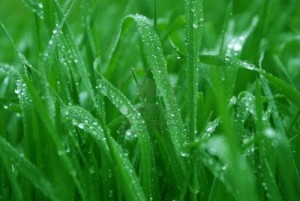
Yet, many landscape sprinkler systems were still running. One has to ask, “Where are all the rain shut-off devices?”. Florida is one of just a few states with a rain sensor statute. Since May 1991, new installations of irrigation systems have been required to include a rain shut-off device. However, no wording was included to cover installation or maintenance. The 2010 statute change now states the following: “Any person who operates an automatic landscape system shall properly install, maintain and operate technology that inhibits or interrupts operation of the system during periods of sufficient moisture.” (Florida Statute 373.62).
Thus, ALL automatic landscape irrigation systems require rain sensors, or other shut-off devices such as soil moisture sensor irrigation controllers. No “grandfather clause” was included for existing systems. Regardless of when it was installed, every sprinkler system must have an operational rain shut-off device. Irrigation contractors can be fined for working on a system without checking out and/or connecting a device.
Moisture sensing technology conserves water, saves money, reduces wear on irrigation system components, reduces disease and helps protect water resources from runoff. Previous research has shown that homeowners using in-ground, automatic irrigation systems, typically in Florida, apply 47% more water for landscape irrigation than homeowners without automatic irrigation systems. This over-irrigation is largely due to a “set it and forget it” mentality despite seasonal fluctuations in plant water needs. If the water costs and the amount of water applied per watering cycle are known, it is easy to calculate how much money is being saved each time the sensor interrupts the program. For example, if a system irrigates ½ acre of turf and is set to deliver ½ inch of water to each zone, approximately 13,576 gallons of water will be used during each watering event. If the cost of the water is $2.00 per thousand gallons, every time the sprinkler system comes on the water bill will be $27.15. A significant amount of money and water can be saved by maintaining a rain shut-off device.
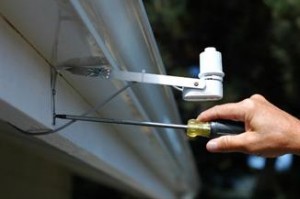 Irrigation is common in Florida landscapes because of sporadic rainfall and the low water holding capacity of sandy soils. Water conservation is a growing issue due to increased demands from a growing population. The least expensive and most common rain sensor device is the expansion disk rain shut-off. Expanding cork disks trigger a pressure switch. The expansion space can be easily adjusted by rotation of the disk cover to a predetermined amount of rain required to trigger the switch. The amount of rain that will interrupt the irrigation system is marked on the adjustment cap. A rain sensor must be mounted where it will be exposed to unobstructed rainfall, typically installed near the roofline on the side of a building.
Irrigation is common in Florida landscapes because of sporadic rainfall and the low water holding capacity of sandy soils. Water conservation is a growing issue due to increased demands from a growing population. The least expensive and most common rain sensor device is the expansion disk rain shut-off. Expanding cork disks trigger a pressure switch. The expansion space can be easily adjusted by rotation of the disk cover to a predetermined amount of rain required to trigger the switch. The amount of rain that will interrupt the irrigation system is marked on the adjustment cap. A rain sensor must be mounted where it will be exposed to unobstructed rainfall, typically installed near the roofline on the side of a building.
Irrigation control technology that improves water application efficiency is now available. Soil moisture sensors (SMS) can reduce the number of unnecessary irrigation events. Most soil moisture sensors are designed to estimate soil volumetric water content based on the soil’s ability to transmit electricity, which increases as the water content of the soil increases. Bypass type soil moisture irrigation controllers use water content information from the sensor to either allow or bypass scheduled irrigation cycles on the irrigation timer. Another type of control technique with SMS devices is “on-demand” where the controller initiates irrigation at a low threshold and terminates irrigation at a high threshold. A single sensor can be used to control the irrigation for many zones or multiple sensors can be used to irrigate individual zones. In the case of one sensor for several zones, the zone that is normally the driest, or most in need of irrigation, is selected for placement of the sensor in order to ensure adequate irrigation in all zones. Sensors should be buried in the root zone of the plants to be irrigated. For turfgrass, the sensor should typically be buried at about three inches deep. The placement of SMS should be at least 5 feet from hard surfaces and sprinkler heads. The sensor needs to be calibrated and/or the soil water content threshold needs to be selected.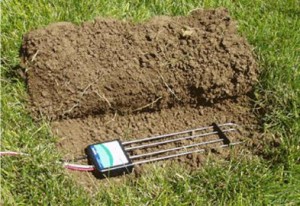
The amount of water that can be saved using rain shut-off devices is substantial. Since the end of March, groundwater levels in the coastal Floridan aquifer shows a slight decline, primarily due to increased pumping from higher seasonal populations during the spring and summer months. In the western panhandle, groundwater levels in the Sand and Gravel aquifer are below normal, which indicates that infiltrating recharge from the above normal rainfall has yet to reach the water table. Remember that every drop that hits the ground will be picking up pollutants as it flows to our groundwater. Nonpoint source pollution is the leading cause of water quality problems. These pollutants have harmful effects on drinking water supplies, recreation, fisheries and wildlife.
By only irrigating when the soil needs it, you are also preventing contamination of drinking water.
by Mary Salinas | Aug 23, 2013
Add the easy-to-grow garden nasturtium to your vegetable or flower garden!
Dress up a ho-hum salad with a vibrant blossom or two just like some of the high-end restaurants. The first taste you experience will be sweetness and then a pleasant peppery flavor emerges. Not only can you eat the flowers but the leaves can also be tossed into your salad and the immature seed pods can be pickled and eaten similar to capers.
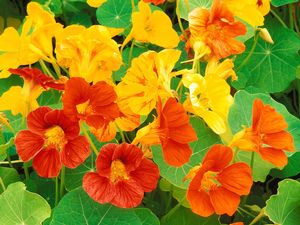
Photo courtesy of the Mendocino Coast Botanical Garden
Garden nasturtium, known to botanists as Tropaeolum majus, is an annual that originated in the Andes of South America. Seed and plants are commonly found in garden centers, although a greater variety is available when purchased from seed catalogues or online. A variety of cultivars are available, from dwarf bushy types to climbing or trailing types. Perky blooms in vivid shades of orange, yellow, pink and red are often produced in abundance.
This annual is easy and fast to grow from seed. If transplanting from small potted plants, make sure not to disturb the delicate root system during the transplant process. Give them partial to full sun and regular watering, even though they are drought tolerant. They prefer a lighter, sandy, well-drained soil and don’t perform as well in dense, rich soils. Be careful with the fertilizer as too much nitrogen will produce lots of green foliage but few blooms.
[warning]Aphids like to feast on the succulent flowers and foliage as well, so be diligent in scouting for this pest. Control is usually adequate by dislodging them with a spray of water or insecticidal soap. Insecticidal soap will cause the aphid to try out and dessicate. Be careful to spray the undersides of the leaves as well for complete control. Make sure to apply products that are safe for food crops and follow all label instructions.[/warning]
In the Florida panhandle, garden nasturtium can be a part of the garden year-round. However, they generally decline and stop flowering with the onset of the full brunt of the summer heat unless a bit of afternoon shade is available. When planted late in the fall, they are susceptible to frost damage but often will recover.
.
For more information from the University of Florida, please see:
Garden Nasturtium, Tropaeoleum majus L.
Gardening in a Minute: Nasturtium
by Matthew Orwat | Aug 19, 2013
Florida Pecan Field Day and Florida Pecan Growers’ Association Annual Meeting
Jefferson County Extension Office 2729 West Washington Street
Monticello, Florida 8:30 AM, EDT
Thursday September 5th
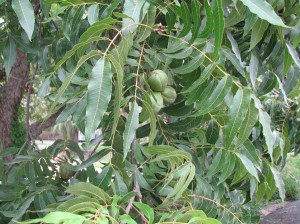 Harvest time is coming for Florida pecan growers. Demand is up, irrigation needs are down, and fungus pressure has been a serious problem over the entire Southeast.
Harvest time is coming for Florida pecan growers. Demand is up, irrigation needs are down, and fungus pressure has been a serious problem over the entire Southeast.
Producers will meet in Monticello on Thursday, September 5 for the annual field day and Pecan Growers’ Association meeting. If you’re a pecan grower, or just considering it, the morning’s topics and speakers will be a great opportunity to learn more about the pecan business.
The agenda is below. For more information, contact Jed Dillard at 850-342-0187
 or dillardjed@ufl.edu. Please make a lunch reservation by noon Tuesday, September 3.
or dillardjed@ufl.edu. Please make a lunch reservation by noon Tuesday, September 3.
Agenda-
- 8:30 Registration
- 9:00 Welcome……… Mark Brown, President Florida Pecan Growers Association and Jed Dillard, Jefferson County Extension Agent
- 9:10-9:45 “Florida Water Policy and Its Impending Effects on Pecan Production” ……. Carlos Herd, Director Division of Water Supply, Suwannee River Water Management District
- 9:45-10:15 “Management strategies and tactics for suppression of pecan arthropod pests: chemicals, trap crops and everything in between.”
- Dr. Russ Mizell, University of Florida Entomologist, Quincy
- 10:05-10:35 “Controlling scab and other pecan diseases” Dr. Tim Brenneman University of Georgia Department of Plant Pathology
- 10:35-10:55 Break
- 10:55-11:25 “Tree Spacing, Alternate Tree Pruning and Removal, and Tree Transplanting”. Dr. Lenny Wells, UGA Extension Pecan Specialist, Tifton
- 11:25- Noon “Direct Marketing of Pecans – What do I need to Know?”…………..Elena Toro, Suwannee County Extension Agent
- Noon…………… Sponsored Lunch
- 1PM Annual Meeting Florida Pecan Growers’ Association
- 1:15 Tour (Tentative)
- CEU’s: two half ceu’s for ag row crop, tree nut, private applicator and demonstration categories
by Blake Thaxton | Aug 19, 2013
It is that time of year where mysterious webs have invaded pecan trees throughout the Southeast United States. This is definitely the case in the panhandle of Florida. Many have called into the extension office asking for identification of the web mass in their pecan trees. It is the Fall Webworm that has made a home in the pecan tree this fall.
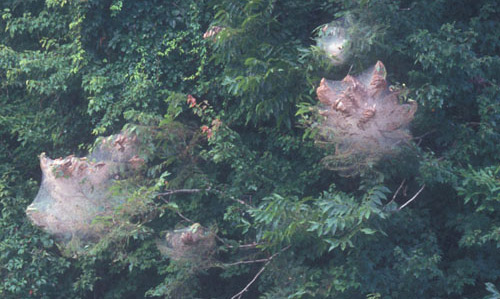
Photograph by James Castner, University of Florida.
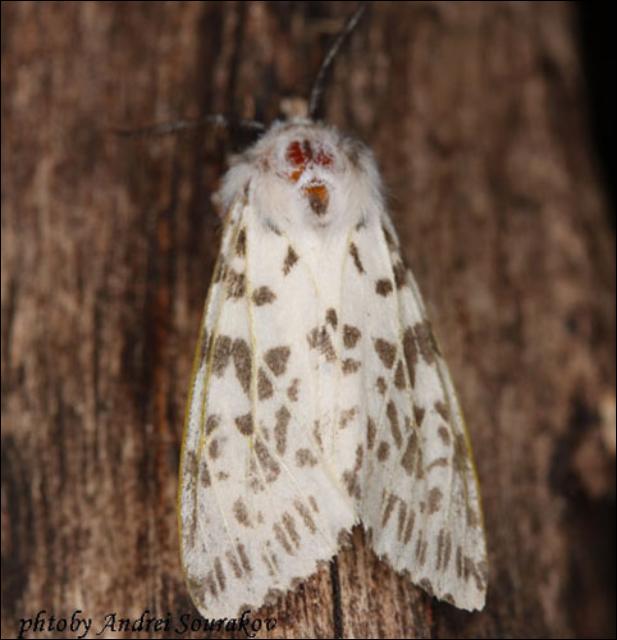
Photograph by Andrei Sourakov, University of Florida.
Fall Webworm
The adult fall webworm is a moth that is bright white in color and may have darker spots on its wings. The larvae of the moth are what lives in the tent web masses. Immediately when the larvae webworm hatches out of the eggs it begins to create its webs around foliage in which it will feed on.
Damage
The damage cause by the feeding of the larvae on the pecan trees is isolated to the leaves and they will not eat the nuts. If Defoliation is severe enough it can reduce the current years crop and the following years crop. Several years of defoliation can lead to death of the tree but this is not likely. Obviously the webs are ugly as well and if the tree is not only a producer of pecans but also functioning as an attractive shade tree in a ornamental since this can be a problem.
Control
In most commercial pecan production settings webworms are not very prevalent because of the spray programs implemented. For residential settings the best solution is to manually prune them out because of the lack of proper spray equipment to cover the entire tree. If the problem is bad enough call your local extension agent to get recommendations on products that could be used.
Sources:
Andrei Sourakov and Thomson Paris (2011, April) Fall webworm,Hyphantria cunea (Drury) (Insecta: Lepidoptera: Arctiidae: Arctiinae). Retrieved from http://edis.ifas.ufl.edu/pdffiles/IN/IN87800.pdf
Michael J. Hall. Fall Webworm. Retrieved from http://www.lsuagcenter.com/NR/rdonlyres/68665E57-A2F4-4030-A4E6-55821DCFBDD6/16783/FallWebworm_sheet_.pdf








